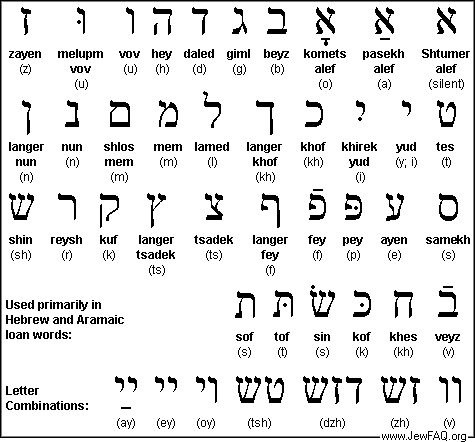Beginner's Yiddish (אָנהײבער ייִדיש)
DISCLAIMER: I'm not a licensed yiddish teacher, so don't take everything written here for truth. You can be pretty sure, though, that most of what you see here is generally correct... If there are any mistakes, please let me know.
Yiddish is much easier to learn than people make it out to be.
Yiddish is a germanic language with a german vocabulary base that borrows heavily from hebrew, slavic (russian, polish) languages, romance (spanish, french) languages, and english too. so if you know any of these, you probably know a lot more yiddish vocabulary than you think.
OK so first things first, you don't necessarily have to be able to read Hebrew characters to learn Yiddish with me, although in the coming notes I will write everything out in Hebrew and English characters. But since most of you can already read Hebrew, you might as well learn how to read Yiddish with the Hebrew alphabet. Yiddish is written with the Hebrew alphabet, which reads from right to left, with a few modifications.
If you already know Hebrew, then I’ll just lay out the basic differences between the Hebrew and the Yiddish alphabet:
- Vowels are completely different from Hebrew. Vowels are freestanding letters or letter combinations. Yiddish does not use dots or dashes, over or under a consonant, to indicate a vowel. The only dots or dashes used on consonants are to indicate hard or soft, e.g. P vs. F (פּ/פֿ)
- Consonants are largely the same, but pay close attention to when dots and dashes are used to indicate hard and soft (yes, it's tedious because the system is inconsistent, but that's what YIVO decided, so live with it). For example, P (פּ) has a dot and F (פֿ) has a dash, whereas K (כּ) has a dot but Kh (כ) has no dash.
- Note that the sounds Tsh, Dzh/J, and Zh are not modified letters like in Hebrew
(צ׳ ,ג׳ ,ז׳), but rather consonant clusters which come together to form the sound, e.g. Dzh/J (דזש) = D (ד) + Z (ז) + Sh (ש).
Once you learn this, we can move on to some basic grammar and vocabulary.

No comments:
Post a Comment